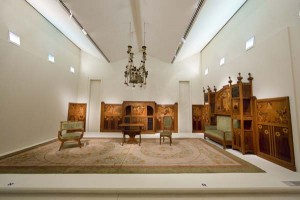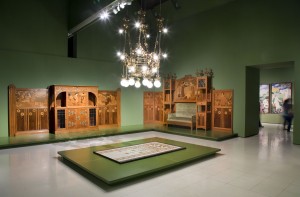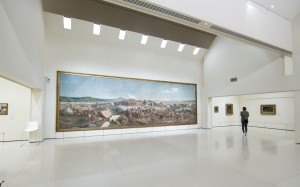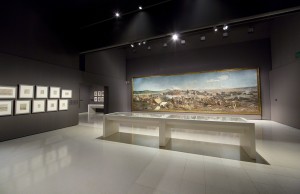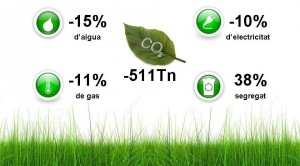Even though we don’t have such an impact on the environment as the industrial sector, museums consume an important amount of energy, above all in terms of air conditioning and heating, as each gallery has to have a specific and constant degree of humidity and temperature, but also due to the lighting of the large spaces of the buildings and the exhibited works.
The idea of the sustainable museum, even though it is very recent within the framework of the museology (the first explicit references to cultural sustainability are from 2002), has become one of the major challenges for museums of this century. Precisely, the theme of the International Museum Day for 2015 proposed by the ICOM is Museums for a sustainable society.
Since the beginning of the 21st century, the term sustainability, which has been active since the eighties in relation to other sectors, has been strongly introduced within the field of museums, probably due to the coincidence of three factors: the economic crisis, the climate change and the unlimited growth of museums throughout the world.
In the Museu Nacional we have taken advantage of the renovation of the spaces of modern art so as to install there energy-saving measures. Therefore, we are not only a more sustainable institution at an environmental level but, moreover, we make savings.
Sustainable measures in the modern art galleries
Led lighting
A system of lighting with Leds has been installed. This signifies major energy saving, given that thanks to the Led technology, we consume 70% less light than before. Moreover, as the Leds heat up less, so the rooms also require less air conditioning.
Minimum light for the maintenance
A system of alternative lighting has been provided for when the rooms are not open to the public, so as to be able to carry out the tasks of maintenance, cleaning and surveillance with the minimum indispensable light.
Lighting before and after the renovation works
Museum controlled by network
Since the renovation, a system of energy management now sends to internet all the consumption data of the modern art rooms. The system of energy management is now installed in nearly all the rooms of the museum, in such a way that we are able to know at all times how much energy is being consumed and we are even able to receive alarms when we are exceeding it.
Intelligent presence detectors
We were pioneers in the Spanish State in the use of presence detectors by luminous control when in 2010 we installed the first ones in the Gothic art rooms; now they are also in the Romanesque and modern art rooms.
The lights which illuminate the artworks turn off automatically when there is nobody in the rooms, but in a smart way, without this being perceptible to the visitors. These same detectors regulate the illumination of the surveillance/cleaning/maintenance when the galleries are closed to the public.
The air that we breathe
In the museum each year more than 6,600 tons of CO2 are generated. However, since 2011, the emissions of CO2 have been reducing by around 10% each year.
There are sound probes installed in the building that measure in a continual way how much CO2 there inisde the museum, in such a way that when the environment is of poor quality, more air from the outside is allowed to enter in a controlled way.
Museu Nacional, Sustainable Museum
The Museu Nacional started to tackle the environmental sustainability when in 2009-2010 it formed part, along with four other museums, of a study commissioned by the Catalan Government, Generalitat, to know what effect the diffusion and awareness-building could have in the society if the museums were involved in the sustainable management.
Now we have two international certifications (ISO14001 and EMAS) which imply having environmental goals and also of diffusion between workers, suppliers and visitors, etc. The aim of the museum is that, at a later stage, more environmental investments are made regarding energy services that will be paid for with the savings we are achieving.
We, as the Museu Nacional form part, therefore of a large number of museums from all over the world that in their construction or in their reforms take into account environmental sustainability in a major way. It was in the third of the so-called Earth Summits, the one of Johannesburg in 2002, in which specific reference was made for the first time to cultural sustainability. The relation between culture and environment progressively is being opened up both at an academic level as well as in terms of cultural policies.
The movement of the green museums started with the children’s museums and the science museums. The Brooklyn’s Children Museum, for example, was the first museum of New York to obtain a certificate as an ecological building. Later on they were joined by the art museums, many of which including, like us, sustainability within their mission. Among the museums in our country, we can find the Fundació Pau Casals, the Fundació Miró, the Museu d’Art de Girona and the Museu de Montserrat. They are, along with the Museu Nacional, the entities that have committed themselves to introducing a project of environmental improvements in accordance with the EMAS regulations after the above-mentioned study.
Related links
Sustainability and museums: Your chance to make a difference. Discussion paper of the Museums Association
Guia per a la implantació d’un sistema de gestió ambiental en entitats culturals of the Generalitat de Catalunya (pdf in Catalan of 187 pages.)
Xavier Abelló
With the collaboration of Ariadna de Vilallonga (journalist doing an internship from a master’s degree Cultural Heritage of the Universitat de Barcelona)
Infraestructures i Serveis Generals. Medi ambient


